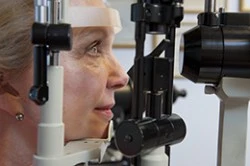While many people are meticulous about taking their automobiles into the shop for an annual tune-up, they often forget to take care of their eyes if they aren’t having any obvious vision problems. But patients with glaucoma can lose up to 40 percent of their sight before they begin to notice any change in their vision. In fact, approximately 50 percent of people with glaucoma are unaware that they have the disease, because the symptoms are not noticeable.

“People are used to being symptomatic for most diseases,” Beth A. Kneib, OD, director of Clinical Resources Group with the American Optometric Association, said. “They think they’ll be symptomatic when glaucoma starts, and that’s not true.”
Glaucoma, a group of eye diseases that cause progressive damage to the optic nerve, can lead to irreversible vision loss, including blindness. Known as the “silent thief of sight,” the disease affects 60 million people worldwide, including 2.2 million in the United States, according to the Glaucoma Research Foundation.
Elevated intraocular pressure (IOP) is the only modifiable risk factor for glaucoma. The eye constantly fills with fluid and drains it through a space between the iris and cornea. When fluid builds up and then drains too slowly, or not at all, it can cause eye pressure to increase, which can damage the optic nerve.
Although the condition is incurable, patients living with glaucoma can be treated with medications, including eye drops and oral therapies. Drainage implants and surgery are also options but tend to be reserved for more severe cases.
While drugs aren’t able to fix the damage already done, effective treatments can reduce ocular pressure and keep the eye stable, potentially slowing further progression of the disease. Through its eye care division, Alcon, Novartis provides treatment solutions for patients living with glaucoma in order to reduce the burden of disease around the world.
One of the best ways to prevent the loss of sight is a regular eye exam. “Typically early loss is from side vision, and you may not notice,” said Andrew Iwach, MD, clinical spokesperson for the American Academy of Opthamologists. “By the time it’s diagnosed, considerable damage may have already been done to the optic nerve.”
Although the risk of glaucoma increases after the age of 40, it can affect small children, young adults and people in their 20s and 30s. Other risk factors, outside of age, include heart disease, high-blood pressure, family history and continuous use of certain medications that contribute to IOP.
But even people without these factors should schedule annual eye exams to test for glaucoma. “It’s important to put a comprehensive eye exam on your annual to do list,” Kneib said.
In addition to detecting glaucoma, the eyes literally provide a window for diagnosis of other diseases. Because the eye is the only part of the body that a doctor can see through the bare artery, nerve and vein without making a single cut, a comprehensive eye exam can also reveal signs of inflammation, diabetes, hypertension and multiple sclerosis.
It’s important for people to not take their eyesight for granted. Even if there is already some loss at the time of diagnosis, salvaging any that is left is important. “Vision is such a precious sense,” said Dr. Iwach. “Even a small amount of vision is important. We fight as hard as we can to preserve vision.”



